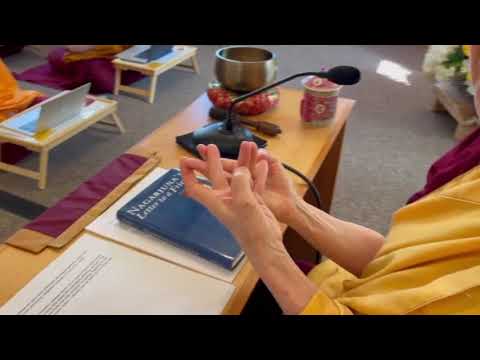Fetters and pollutants
27 Samsara, Nirvana, and Buddha Nature
Part of an ongoing series of teachings (retreat and Friday) based on the book Samsara, Nirvana, and Buddha Nature, the third volume in The Library of Wisdom and Compassion series by His Holiness the Dalai Lama and Venerable Thubten Chodron.
- Identifying our emotions and cultivating mental states to counteract them
- Explanation of fetters and four stages of the path in Pali tradition
- Stream-enterer, once-returner, non-returner and arhat
- Lower fetters and higher fetters
- View of a personal identity, deluded doubt and view of rules and practices
- Sensual desire and malice
- Desire for existence in form realm and formless realm
- Arrogance, restlessness and ignorance
- Explanation of pollutants
- Pollutant of sensuality, existence, ignorance and views
Samsara, Nirvana, and Buddha Nature 27: Fetters and Pollutants (download)
Contemplation points
- What are some reasons why it may be difficult for some people to identify needs in themselves? Do you ever find this true for yourself?
- Why is it so important for Dharma practitioners to be able to identify what they are thinking and needing? What are some common needs you have? Investigate them. Can they be met in ways you haven’t considered before? Are they based in the afflictions? Are there other ways you can view your experience that would be more beneficial and realistic? Spend some time with this.
- Although each of the fetters is present in our mind, which do you find are most obvious in your experience? Which antidotes help you most when working with these fetters? How can you strengthen those antidotes?
- The pollutants are triggered when we have contact with certain objects. Consider each of the pollutants and the objects that are the strongest triggers in your own experience. What antidotes can you apply to begin to weaken these pollutants when they arise in your mind?
Venerable Thubten Chodron
Venerable Chodron emphasizes the practical application of Buddha’s teachings in our daily lives and is especially skilled at explaining them in ways easily understood and practiced by Westerners. She is well known for her warm, humorous, and lucid teachings. She was ordained as a Buddhist nun in 1977 by Kyabje Ling Rinpoche in Dharamsala, India, and in 1986 she received bhikshuni (full) ordination in Taiwan. Read her full bio.


